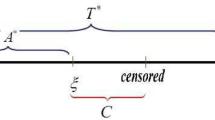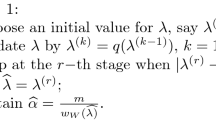Abstract
Traditional analysis with truncated survival data has been developed under the assumption that the lifetime variable of interest is statistically independent of the truncation variable. However, empirical evidence has shown that the truncation variable may depend on the lifetime of interest in many real-world examples. The lack of independence can lead to seriously biased analysis. In this article, we revisit an existing estimation procedure for survival under a copula-based dependent truncation model. Here, the same estimating equation is adopted but a different algorithm to solve the equation is proposed. We compare the new algorithm with the existing one and discuss its theoretical and practical usefulness. Real data examples are analyzed for illustration. We implemented the proposed algorithm in an R “depend.truncation” package, available from CRAN.




Similar content being viewed by others
Notes
One can replace the estimating equation of Chaieb et al. (2006) by the estimating equation of Emura et al. (2011). We refer the detailed results under the estimating equation of Emura et al. (2011) to the Supplemental Materials. Although we found some numerical difference between the two approaches of Chaieb et al. (2006) and Emura et al. (2011), the substantive conclusions on the resident’s lifetime distribution are similar. Please refer to the Supplemental Materials for the detailed comparison.
One can replace the estimating equation of Chaieb et al. (2006) by the estimating equation of Emura et al. (2011). Although the two estimating equations are different, there is virtually no numerical difference between the two estimates. This phenomenon occurs in the absence of censoring (Emura et al. 2011).
References
Andersen PK, Keiding N (2002) Multi-state models for event history analysis. Stat Methods Med Res 11:91–115
Bakoyannis G, Touloumi G (2012) Practical methods for competing risks data: a review. Stat Method Med Res 21:257–272
Beaudoin D, Lakhal-Chaieb L (2008) Archimedean copula model selection under dependent truncation. Stat Med 27:4440–4454
Braekers R, Veraverbeke N (2005) A copula-graphic estimator for the conditional survival function under dependent censoring. Can J Stat 33:429–447
Chaieb LL, Rivest LP, Abdous B (2006) Estimating survival under a dependent truncation. Biometrika 93:655–69
Chen CH, Tsai WY, Chao WH (1996) The product-moment correlation coefficient and linear regression for truncated data. J Am Stat Assoc 91:1181–1186
Chen YH (2010) Semiparametric marginal regression analysis for dependent competing risks under an assumed copula. J R Stat Soc Ser B 72:235–251
de Uña-Álvarez J (2012) On the Markov three-state progressive model; recent advances in system reliability. Springer, New York
Ding AA (2012) Copula identifiability conditions for dependent truncated data model. Lifetime Data Anal 18(4):397–407
Emura T (2014) R depend.truncation: statistical inference for parametric and semiparametric models based on dependently truncated data. Version 2.1, CRAN
Emura T, Wang W (2010) Testing quasi-independence for truncation data. J Multivar Anal 101:223–239
Emura T, Wang W, Hung HN (2011) Semi-parametric inference for copula models for truncated data. Stat Sin 21:349–367
Emura T, Wang W (2012) Nonparametric maximum likelihood estimation for dependent truncation data based on copulas. J Multivar Anal 110:171–188
Emura T, Konno Y (2012) Multivariate normal distribution approaches for dependently truncated data. Stat Pap 53:133–149
Emura T, Chen YH (2014) Gene selection for survival data under dependent censoring: a copula-based approach. Stat Methods Med Res. doi:10.1177/0962280214533378
Escarela G, Carriere JF (2003) Fitting competing risks with an assumed copula. Stat Methods Med Res 12:333–349
Genest C, Mackay RJ (1986) The joy of copulas: bivariate distributions with uniform marginals. Am Stat 40:280–283
He S, Yang GL (1998) Estimation of the truncation probability in the random truncation model. Ann Stat 26:1011–1027
Hyde J (1977) Testing survival under right censoring and left truncation. Biometrika 64:225–230
Hyde J (1980) Survival analysis with incomplete observations. In: Miller RG, Efron B, Brown BW, Moses LE (eds) Biostatistics casebook. Wiley, New York, pp 31–46
Klein JP, Moeschberger ML (2003) Survival analysis: techniques for censored and truncated data, 2nd edn. Springer, New York
Lagakos SW, Barraj LM, De Gruttola V (1988) Non-parametric analysis of truncated survival data with application to AIDS. Biometrika 75:515–23
Lai TL, Ying Z (1991) Estimating a distribution function with truncated and censored data. Ann Stat 19:417–442
Lynden-Bell D (1971) A method of allowing for known observational selection in small samples applied to 3RC quasars. Mon Nat R Astron Soc Lett 155:95–118
Martin EC, Betensky RA (2005) Testing quasi-independence of failure and truncation via conditional Kendall’s tau. J Am Stat Assoc 100:484–492
Murotani K, Zhou B, Kaneda H, Nakatani E, Kojima S, Nagai Y, Fukushima M (2014) Survival of centenarians in Japan. J Biosoc Sci. doi:10.1017/S0021932014000388
Nelsen RB (2006) An introduction to copulas. Springer, New York
Rivest LP, Wells MT (2001) A martingale approach to the copula-graphic estimator for the survival function under dependent censoring. J Multivar Anal 79:138–155
Rodriguez-Girondo M, de Uña-Álvarez J (2012) Testing Markovian in the three-state progressive model via future-past association. Biom J 54(2):163–180
Sibuya M, Hanayama N (2004) Estimation of human longevity distribution based on tabulated statistics. Proc Inst Stat Math 52:117–134
Strazalkowska-Kominiak E, Stute W (2013) Empirical copulas for consequtive survival data: copulas in survival analysis. TEST 22:688–714
Tsai WY (1990) Testing the association of independence of truncation time and failure time. Biometrika 77:169–177
Wang MC, Jewell NP, Tsai WY (1986) Asymptotic properties of the product-limit estimate under random truncation. Ann Stat 13:1597–1605
Zheng M, Klein J (1995) Estimates of marginal survival for dependent competing risks based on an assumed copula. Biometrika 82:127–38
Acknowledgments
We are grateful to Professor Weijing Wang for raising the main idea of the method. We also thank the associate editor and the reviewer for their careful reading of our manuscript and their helpful comments that substantially improve the manuscript. This work is supported by the research grant funded by the National Science Council of Taiwan (NSC 101-2118-M-008-002-MY2), the Ministry of Science and Technology of Taiwan (MOST 103-2118-M-008-MY2) and MEXT KAKENHI, Grant-in-Aid for Scientific Research (C) 13203524 of Japan.
Author information
Authors and Affiliations
Corresponding author
Electronic supplementary material
Below is the link to the electronic supplementary material.
Rights and permissions
About this article
Cite this article
Emura, T., Murotani, K. An algorithm for estimating survival under a copula-based dependent truncation model. TEST 24, 734–751 (2015). https://doi.org/10.1007/s11749-015-0432-8
Received:
Accepted:
Published:
Issue Date:
DOI: https://doi.org/10.1007/s11749-015-0432-8
Keywords
- Archimedean copula
- Bivariate survival function
- Copula-graphic estimator
- Kendall’s tau
- Left truncation
- Product-limit estimator




